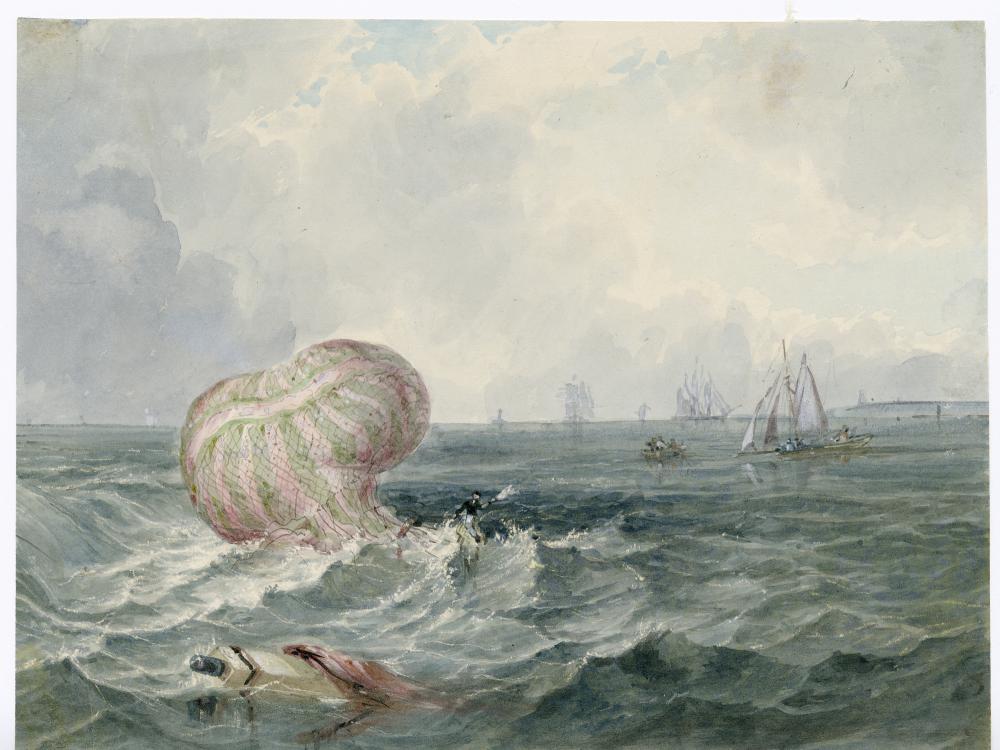
Lost Balloons: Depicting the Dangers of Early Ballooning
May 08, 2017
By Tom Crouch

May 08, 2017
By Tom Crouch
The dangers of ballooning were apparent to aeronauts and the general public. From the early 1800s, attempts to fly over water too often ended in disaster or a narrow escape. Some of the best known aeronauts on both sides of the Atlantic set off across a large body of water never to be seen again. The daring rescue of balloonists from water was a favorite subject with artists and engravers. The vision of a “lost balloon” vanishing over the horizon became a metaphor for the uncertainties of life in the turbulent 19th century.
On the afternoon of July 22, 1785, Major John Money (1752-1817), on half-pay from the 15th Light Dragoons, took off from the Ranleigh Gardens, Norwich, to raise money for the Norfolk and Norwich Hospital. A skilled horseman, he had made only one previous ascent from London in the British Balloon. By 6:00 pm on the evening of the launch, he was seen crossing Lowestoft, unable to descend and heading out over the North Sea. The balloon descended as the air cooled, depositing Money in the water on the Long Shoals, a dangerous area for ships. He abandoned his basket and climbed onto the load ring of the balloon, keeping enough hydrogen in the envelope to keep him afloat. He was rescued by the lifesaving vessel Argus, out of Lowestoft, at midnight. Before his ascent, Money had served under Gen. John Burgoyne, was captured at Saratoga, and spent time as an American prisoner of war. Later during the Napoleonic Wars he was commissioned as Major General serving with the rebel Austrian forces.
Another view of Major John Money, his name misspelled in the title.
Etching, English, 18th century
Rescue of a balloonist near Savannah, Georgia. One of the balloonists is climbing down a rope from the balloon to a row boat. The other two balloonists are falling from the balloon to the water below.
Newspaper engraving, American 19th century
Despite taunts from the crowd and considerable wind, Jules Duruof and his wife launched from the Place d'Armes, Calais, in July 1874. They were blown out to sea and presumed lost. This scene is their rescue from the North Sea by the crew of a British fishing boat, Grand Charge.
Charles John de Lacy
Watercolor and gouache on paper
English, 1874 (?)
Before ascending on that fateful day, Duruof remarked, "Let us show then that we are not afraid to die."
This lithograph was signed by Duruof on June 6, 1874. It is of the 'Le Tricolore' balloon flown by Duruof (1841-1899), one of the aeronaut heroes of the Siege of Paris.
The Descent of Mr. Livingston on the Coast of Baldoyle, County of Dublin, on Thursday the 27th of June 1822
Aquatint, English, 1822 (?)
Mrs. Graham's Balloon Ascent with the Duke of Brunswick, 22nd August 1836
E. W. Cocks
Oil on panel, English, c. 1836
Mr. Sadler and his companion, a Mr. Clayfield, inadvertently descend into the Bristol Channel on September 24, 1810. Rescue is on the way.
Print, Aquatint on Paper, Colored, English, 1810
James Sadler is rescued by a fisherman after being forced down in the water during an attempt to cross the Irish Sea on October 1, 1812.
Somers, Watercolor, English, 19th century
Another view of the watery conclusion of James Sadler's 1810 ascension from Bristol.
Somers
Watercolor, English, 19th century
Untitled
Chromolithograph, French, late 19th century
We rely on the generous support of donors, sponsors, members, and other benefactors to share the history and impact of aviation and spaceflight, educate the public, and inspire future generations. With your help, we can continue to preserve and safeguard the world’s most comprehensive collection of artifacts representing the great achievements of flight and space exploration.